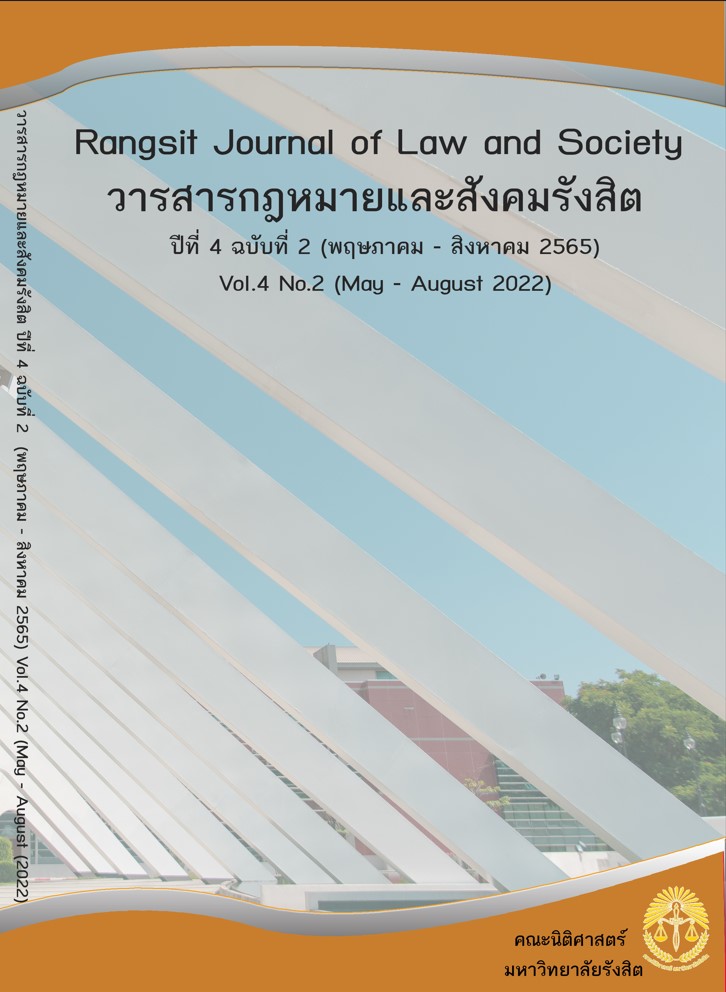ความจำเป็นที่ต้องร่างประมวลกฎหมายแพ่งใหม่ในประเทศไทย
Main Article Content
บทคัดย่อ
ประเทศไทยปฏิรูประบบกฎหมายมานานกว่า 100 ปีมาแล้ว โดยรับเอากฎหมายแบบแองโกล-แซกซอนจากอังกฤษมาใช้ก่อนจะรับเอากฎหมายแบบโรมันจากภาคพื้นยุโรป โดยเริ่มแรกพระบาทสมเด็จพระจุลจอมเกล้าเจ้าอยู่หัวทรงแต่งตั้งคณะกรรมการร่างประมวลกฎหมายแพ่งและพาณิชย์ (ปพพ.) เป็นคณะแรกในปีพ.ศ.2451 แต่ร่างเสร็จในปีพ.ศ. 2468 ในรัชสมัยพระบาทสมเด็จพระมงกฎเกล้าเจ้าอยู่หัว เนื่องจากคณะกรรมการร่างกฎหมายไม่เข้าใจหลักการและแนวคิดต้นตอของกฎหมายที่ตัวเองลอกเลียนมาจึงทำให้ตีความประมวลกฎหมายแพ่งและพาณิชย์ได้ยาก คณะกรรมการไม่ได้แยกประมวลกฎหมายแพ่งและพาณิชย์ออกจากกันเหมือนกับของฝรั่งเศส เยอรมนีและญี่ปุ่นซึ่งเป็นประเทศต้นแบบของประมวลกฎหมายนี้แต่รวมเข้าไปแบบประมวลกฎหมายแพ่งและหนี้ของสวิส นอกจากนี้กฎหมายแบบแองโกล-แซกซอนได้หยั่งรากลึกในระบบกฎหมายไทยทำให้มีการใช้นิยามในกฎหมายแบบแองโกล-แซกซอนเข้ามาในประมวลกฎหมายแพ่งทำให้เกิดความสับสนในการตีความ การที่จะร่างประมวลกฎหมายแพ่งขึ้นมาใหม่โดยแยกกฎหมายพาณิชย์ทั้งหมดเข้าเป็นประมวลกฎหมายพาณิชย์แยกต่างหาก ผู้ร่างกฎหมายแพ่งไทยควรจะมองไปที่ประเทศที่มีการร่างประมวลกฎหมายแพ่งขึ้นมาใหม่ล่าสุดโดยจัดโครงสร้างต่างจากประมวลกฎหมายแพ่งฝรั่งเศส เยอรมนีหรือสวิสเซอร์แลนด์ที่เคยใช้เป็นแบบร่างประมวลกฎหมายแพ่งฉบับเก่าของประเทศตนอย่างเช่น เนเธอร์แลนด์ บราซิล เปรูและมณฑลควิเบก ประเทศแคนาดา และใช้หลักการและแนวคิดต้นตอกฎหมายแบบโรมันจากเขตปกครองที่ใช้กฎหมายแบบโรมันในประเทศที่ใช้ภาษาอังกฤษเป็นภาษาแม่ เช่น สก็อตแลนด์ในสหราชอาณาจักร รัฐหลุยส์เซียน่าในสหรัฐอเมริกา และแอฟริกาใต้มาเป็นบทบัญญัติต่างๆ ในประมวลกฎหมายแพ่งใหม่นี้ทั้งในภาษาไทยและการแปลเป็นภาษาอังกฤษเข้าแทนที่หลักการและแนวคิดต้นตอของกฎหมายแบบแบบแองโกล-แซกซอนที่ปะปนอยู่ในประมวลกฎหมายแพ่งและพาณิชย์ฉบับเดิม
Article Details

อนุญาตภายใต้เงื่อนไข Creative Commons Attribution-NonCommercial-NoDerivatives 4.0 International License.
เอกสารอ้างอิง
เกียรติกำจร มีขนอน. (2565). ความจำเป็นที่ต้องแยกประมวลกฎหมายแพ่งและพาณิชย์ออกจากกันในประเทศไทย. วารสารกฎหมายและสังคมรังสิต, 4(1), 65.
Beviláqua, C. (1927). Codigo Civil dos Estados Unidos do Brazil. Rio de Janeiro: F. Alves.
Bucher, E. (2004). Law of contracts. In F. D. Ansay, Introduction to Swiss Law (pp. 103-131). Bosten & London: Kluwer/Schithess.
Dutch Civil Law. (2022, April 22). Dutch Civil Code. Retrieved from www.dutchcivillaw.com/civilcodegeneral.htm
Huxley. A. (1996). Thai law: Buddhist law: Essay on the legal history of Thailand. Bangkok: Orchid Press Publishing.
Ipderecho.pe. (2022, July 9). Código Civil Peruano. Retrieved from http://lpderecho.pe/codigo-civil-peruano-realmente-actualizado
Japanese Law Translation. (2022, April 22). Civil Code (Part I, Part III, Part III). Retrieved from www.japaneselawtranslation.go.jp/en/law/view/3494
Lawyrup. (2022, April). Burgerlijk Wetboek (BW). Retrieved from https://lawyrup.nl/burgerlijk-wetboek
LégisQuébec. (2022, April). Code Civil du Québec. Retrieved from http://legisquebec.gouv.qc.ca/fr/document/lc/CCQ-1991
LezaLegalwise. (22 April 2022). Juristic person. Retrieved from http://www.legalwise.co.za/help-youself/glossary-terms
LSU Law. (2022, April 22). Louisiana Civil Code online. Retrieved from http://lcco.law.lsu.edu
Meekanon. K. (2013). The possibility of transferring continental Europe corporate governance system to Thailand. Bangkok: Chulalongkorn University.
Parodi, F. O. (1983). Peruvian Civil Code. Retrieved from University of Miami Inter-American Law Review: http://repositorylaw.miami.eud/umia/vol14/1553/7
Pierre, B. (1997). Classification of property and conception of ownership in civil and common law. Revue Générale de droit, 28(2), 235-274.
Pimngam, S. (2019). Codifying the Civil and Commercial Code of Thailand. Retrieved from The Structure of Thai Civil Law: https://businessanalysisoflaw.com/2019/07/23/codifying-civil-and-commercial-code-thailand
Pongsapan. M. (2021). The fundamental misconceptions in the drafting of Thai Civil and Commercial Code of 1925. In A. H. (eds.), Thai legal history: From traditional to modern law (pp. 122-137). Cambridge: Cambridge University Press.
Presidência da República. (2022, April 22). Institui o Código Civil. Retrieved from http://www.planalto.gov.br/ccivil_03/leis/2002/l10406compilada.htm
Tamura, S. (2013). The Thai civil law on non-performance in comparative,structural view- from past into its future. Law Journal Thammasat University, 42(2), 897-925.
Teixeira de Freitas, A. (1864). Código civil – Esboço. Rio de Janeiro: Typographia Universal de Laemmert.
Van Vliet, L. (2014). The Netherlands-New developments in Dutch company law: The flexible close corporation. Journal of Civil Law Studies, 7(1), 271-286.

